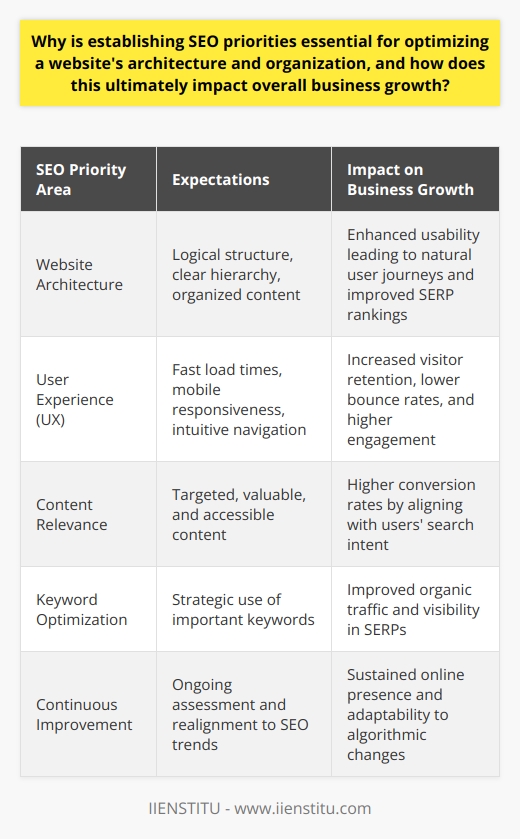
Priority ratings for business objectives are an essential tool for any organization. By assigning ratings to tasks and objectives, companies can determine which tasks to prioritize and which to devote fewer resources to.
This helps ensure that resources are allocated most efficiently, and tasks are completed promptly. There are various ways to represent priority, including setting specific keywords as a top priority, estimating the value of each conversion, and developing a basic rating system.
This article discusses the benefits and uses of priority ratings for business objectives. Priority ratings allow companies to prioritize tasks and objectives to maximize their resources and optimize their success.
Different ways to represent priority are introduced, such as setting specific keywords as a top priority, estimating the value of each conversion, and developing a basic rating system. It is concluded that priority ratings are an essential tool for any organization, as they help to ensure that resources are allocated most efficiently and that tasks are completed in a timely fashion.
Introduction
What are Priority Ratings for Business Objectives?
Benefits of Using Priority Ratings
Different Ways to Represent Priority
Setting Certain Keywords as a Top Priority
Introduction: Priority ratings for business objectives are essential for any organization. They allow companies to prioritize tasks and objectives to maximize their resources and optimize their success.
By assigning ratings to tasks and objectives, companies can determine which tasks to prioritize and which to devote fewer resources to.
This article will discuss the benefits of using priority ratings and explore ways to represent priority. We will also introduce a suggested rating system and discuss how to assign scores or flags to tasks and objectives.
What are Priority Ratings for Business Objectives?
Priority ratings for business objectives are a means of assigning importance to tasks and objectives. By assigning ratings to tasks, companies can determine which tasks to prioritize and which to devote fewer resources to.
This helps ensure that resources are allocated most efficiently and tasks are completed promptly.
Benefits of Using Priority Ratings
Priority ratings for business objectives can help organizations to optimize their success and maximize their resources. By assigning ratings to tasks and objectives, organizations can determine which tasks to prioritize and which to devote fewer resources to. This helps ensure that resources are allocated most efficiently, and tasks are completed promptly.
Additionally, priority ratings can help organizations identify tasks that are not as important and can be de-prioritized. This helps to ensure that resources are not wasted on tasks that are not as important.
Different Ways to Represent Priority
There are a variety of different ways to represent priority. The best way to represent priority will depend on the details of the business and the objectives that need to be prioritized.
Some of the most common ways to represent priority include setting certain keywords as a top priority, estimating the value of each conversion, and developing a basic rating system.
Setting Certain Keywords as a Top Priority
One way to represent priority is to set specific keywords as a top priority. This can be done by assigning a higher priority rating to specific keywords.
For example, if a company focuses on SEO, it may assign a higher priority rating to specific keywords important for SEO. This will help ensure that the company focuses its resources on the most important keywords.
Estimating the Value of Each Conversion
Another way to represent priority is to estimate the value of each conversion. This can be done by assigning a higher priority rating to more valuable conversions.
For example, if a company is trying to increase sales, it may assign a higher priority rating to conversions that lead to more sales. This will help ensure that the company focuses its resources on the most valuable conversions.
Developing a Basic Rating System
A third way to represent priority is to develop a basic rating system. This can be done by assigning a rating to each task or objective.
For example, a company may assign a rating of 1 to tasks that are the most important, a rating of 2 to essential tasks, and a rating of 3 to tasks that are not as important. This will help ensure that the company focuses its resources on the most critical tasks.
Suggested Rating System
When assigning priority ratings for business objectives, it is essential to use a rating system that is consistent and easy to understand. One suggested rating system is the Boolean flag system. This system assigns a flag (true or false) to each task or objective. This allows for easy sorting and filtering of tasks and objectives.
Another suggested rating system is the numeric scale system. This system assigns a numeric value to each task or objective. This allows for easy sorting and filtering of tasks and objectives.
Finally, a third suggested rating system is the product management perspective system. Based on the product management perspective, this system assigns a rating to each task or objective. This allows for easy sorting and filtering of tasks and objectives.
Assigning Scores or Flags
Once a rating system has been selected, assigning scores or flags to tasks and objectives is essential. This can be done in the priority column of the task or objective. This allows for easy sorting and filtering of tasks and objectives.
Conclusion: Priority ratings for business objectives are essential for any organization. They allow companies to prioritize tasks and objectives to maximize their resources and optimize their success. By assigning ratings to tasks and objectives, companies can determine which tasks to prioritize and which to devote fewer resources to.
There are various ways to represent priority, including setting specific keywords as a top priority, estimating the value of each conversion, and developing a basic rating system.
Additionally, it is crucial to select a rating system that is consistent and easy to understand and to assign scores or flags to tasks and objectives.
Organizations can use priority ratings for business objectives to ensure that resources are allocated most efficiently and that tasks are completed promptly.
SEO Priority Ratings are the key to unlocking your business's potential
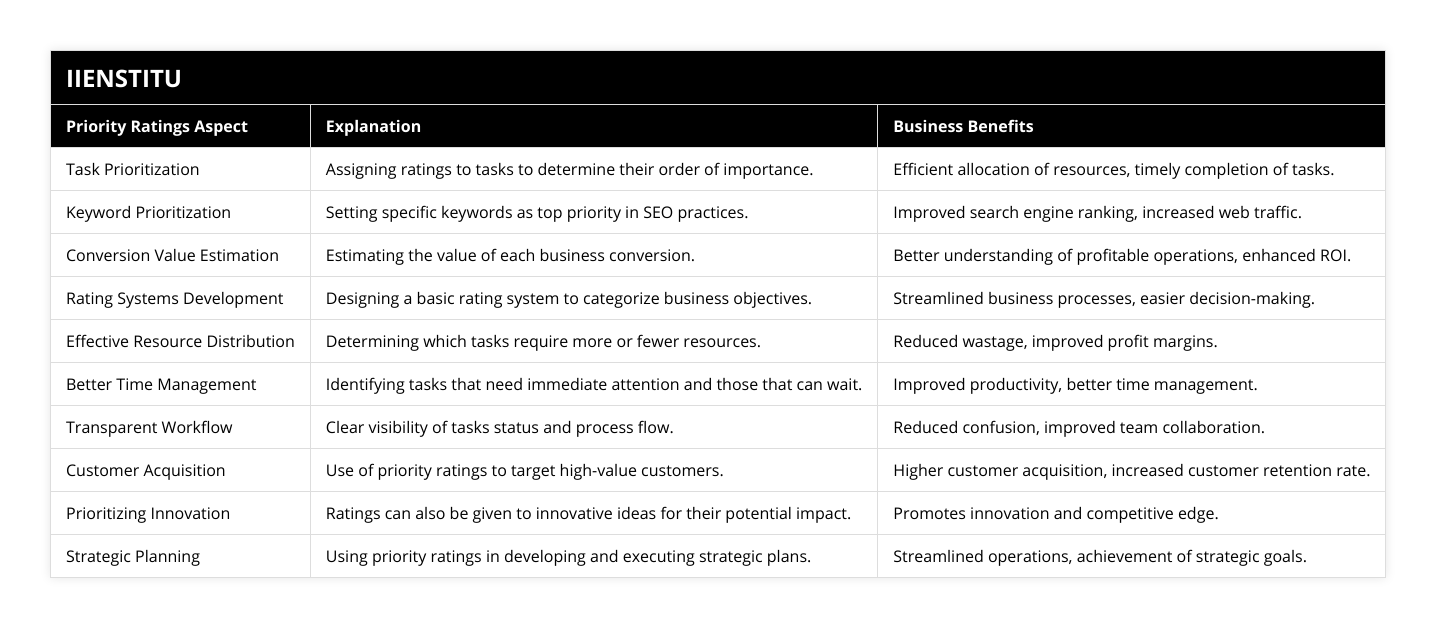
Frequently Asked Questions
What are the benefits of using priority ratings for business objectives?
Priority ratings are an effective tool for businesses to measure the relative importance of business objectives. By assigning a numerical value to each objective, businesses can determine how much effort and resources should be allocated to each objective. This helps ensure that resources are used efficiently and that the most critical objectives are given the attention they deserve.
One of the main benefits of using priority ratings is that it helps businesses to identify their most important objectives. By assigning a numerical value to each objective, businesses can see which objectives are the most important and should be given the highest priority. This helps ensure that resources are used efficiently and that the most important objectives are given the attention they deserve.
Another benefit of priority ratings is that it can help businesses to set realistic goals. By assigning a numerical value to each objective, businesses can determine how much effort and resources should be allocated to each objective. This helps ensure that businesses are realistic about what can be achieved in a given time frame.
Finally, priority ratings can help businesses to track and measure progress toward achieving their objectives. By assigning a numerical value to each objective, businesses can track the progress of each objective and determine whether or not objectives are being met. This helps businesses stay on track and remain focused on achieving their objectives.
In conclusion, priority ratings are a valuable tool for businesses to measure the relative importance of their business objectives. By assigning a numerical value to each objective, businesses can identify their most important objectives, set realistic goals, and track and measure progress toward achieving them. This helps ensure that resources are used efficiently and that the most important objectives are given the attention they deserve.
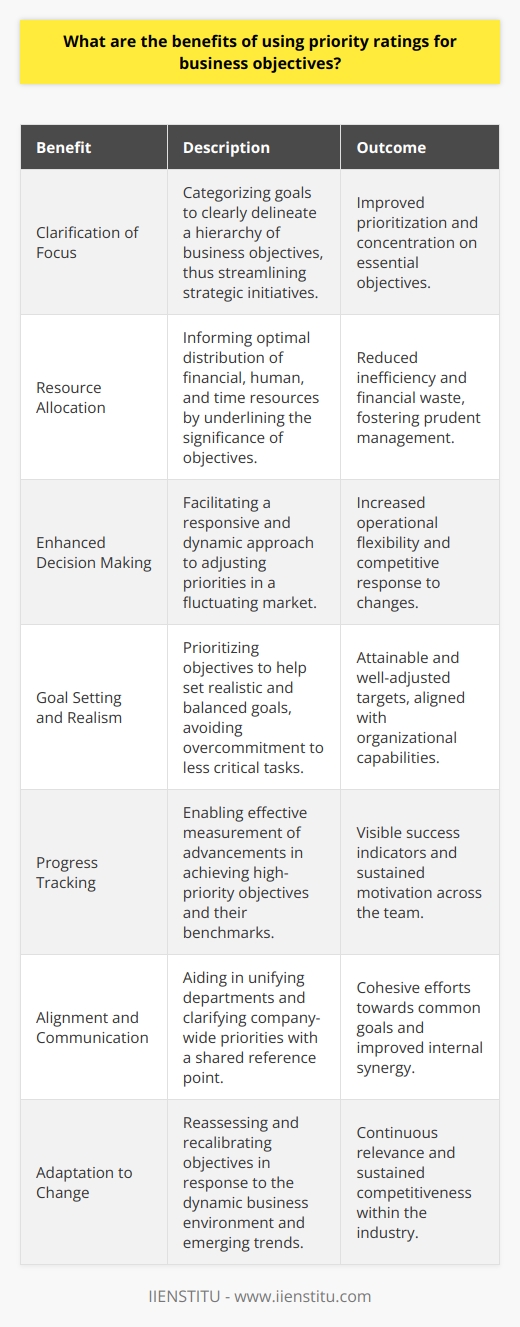
How can I set certain keywords as a top priority?
When optimizing a blog post for search engine optimization (SEO), keywords play an essential role. Keywords are the words or phrases people use when searching for information on the internet. You can ensure that the right people see your blog post by targeting specific keywords as a top priority.
The first step in setting specific keywords as a top priority is to conduct keyword research. This involves using various tools to identify the best keywords for your blog post. A variety of tools are available for this purpose, including keyword research tools, such as Google AdWords Keyword Planner, and competitor analysis tools, such as Moz Keyword Explorer. Once you have identified the best keywords for your blog post, you can prioritize them by relevance, popularity, and competition.
Once you have identified and prioritized the best keywords for your blog post, the next step is to incorporate them into your blog post. To do this, you will need to use them in your post's title, headings, meta-description, and body. It is also essential to ensure that the keywords are used naturally and not overused. Too many keywords can lead to keyword stuffing, negatively impacting your search engine rankings.
Finally, it is essential to monitor the performance of your keywords. This can be done by using tools such as Google Analytics or Ahrefs. These tools allow you to track the number of visitors to your blog post and the keywords that drive the most traffic. By monitoring the performance of your keywords, you can determine whether or not they are working as intended and make adjustments as needed.
In conclusion, setting specific keywords as a top priority for your blog post is an essential step in optimizing your blog for search engine optimization. By conducting keyword research, prioritizing the best keywords, incorporating them naturally into your blog post, and monitoring the performance of your keywords, you can ensure that the right people see your blog post.

What is the suggested rating system for assigning scores or flags in the priority column?
Prioritizing tasks can be an overwhelming and daunting process. It is essential to have a rating system to ensure that tasks are completed efficiently and effectively. This article will discuss the suggested rating system for assigning scores or flags in the priority column.
A rating system is a way to assign a numerical value to tasks to prioritize them. The score or flag assigned to each task will help determine which tasks are the most important and must be completed first. Generally, higher scores or flags will indicate tasks that should be given the highest priority, while lower scores or flags will indicate tasks that can be completed later.
The rating system for assigning scores or flags in the priority column should be tailored to the organization's specific needs. For example, a rating system of 1 to 5 might be used, with 1 being the highest priority and 5 being the lowest priority. Alternatively, a rating system of flags might be used, such as red for highest priority, yellow for medium priority, and green for lowest priority.
The rating system should be easy to understand and use. It should be intuitive and clearly defined so everyone in the organization can understand and use it when prioritizing tasks. Additionally, the rating system should be flexible enough to accommodate changes in priorities as needed.
It is also essential to consider the impact of the rating system on the overall workflow. If the rating system is too complex or time-consuming, it may impede the workflow and lead to unnecessary delays in completing tasks. Additionally, the rating system should not create a false sense of urgency; it should be used to prioritize tasks based on their importance.
In conclusion, it is essential to have a rating system for assigning scores or flags in the priority column to prioritize tasks effectively. The rating system should be tailored to the organization’s needs and easy to understand and use. Additionally, it should be flexible and not used to create a false sense of urgency. By considering these factors, organizations can ensure that tasks are completed efficiently and effectively.
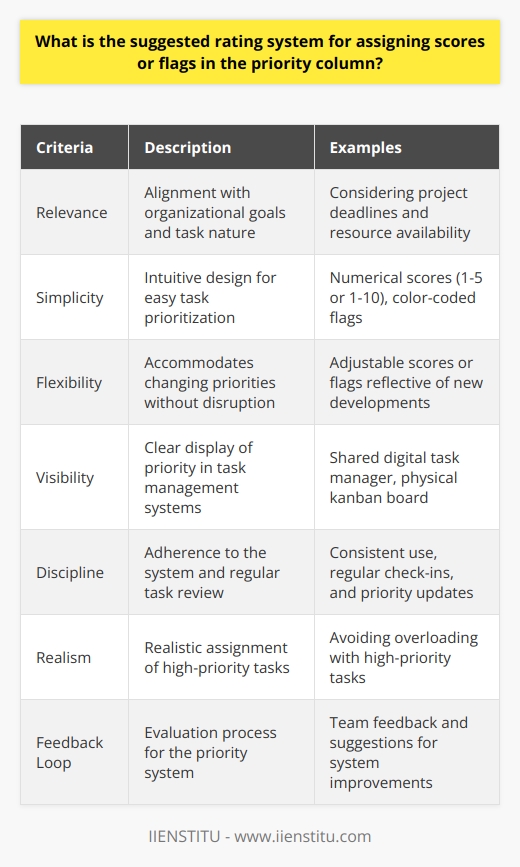
How can SEO and business objectives work together to optimize online presence and achieve growth?
Integration of SEO and Business Objectives
SEO, or Search Engine Optimization, and business objectives often work seamlessly together to enhance online presence and further corporate growth. SEO techniques provide a boost to visibility by increasing website traffic, enhancing brand awareness.
Mutual Interplay
Essentially, SEO can aid businesses in accomplishing their primary goals, such as sales maximization or heightened brand awareness. This interplay happens by utilizing effective keywords or phrases related to the business, improving website performance and creating quality content that attracts and retains users.
Role of SEO
We can view SEO as a tool that helps businesses reach their target audience effectively. By using SEO strategies, companies ensure their website appears in search results when potential customers search for relevant products or services. Thus, SEO assists in achieving high sales by driving more traffic to the website and converting visitors into customers.
Crucial Keyword Research
Conducting keyword research serves as a critical initial step in any SEO strategy. Identifying and using the right keywords can help businesses ensure their content is visible to the right audience, leading to better engagement rates and customer retention.
Website Performance
Optimal website performance is another crucial aspect where SEO and business objectives intersect. A well-performing, user-friendly website translates to better user experiences, leading to higher customer retention. SEO improvements such as fast load times, mobile optimization, and intuitive site navigation can significantly enhance website performance.
Promotion of Quality Content
Quality content development plays a pivotal role as well. Producing engaging, informative, and valuable content can draw users in, keep them engaged with the brand, and eventually convert them into customers. SEO promotes this high-quality content, ensuring it reaches the target audience.
In conclusion, SEO can substantially aid in meeting business objectives. Its ability to improve online presence makes it a powerful tool that can complement and enhance many business strategies, thereby contributing to overall corporate growth.
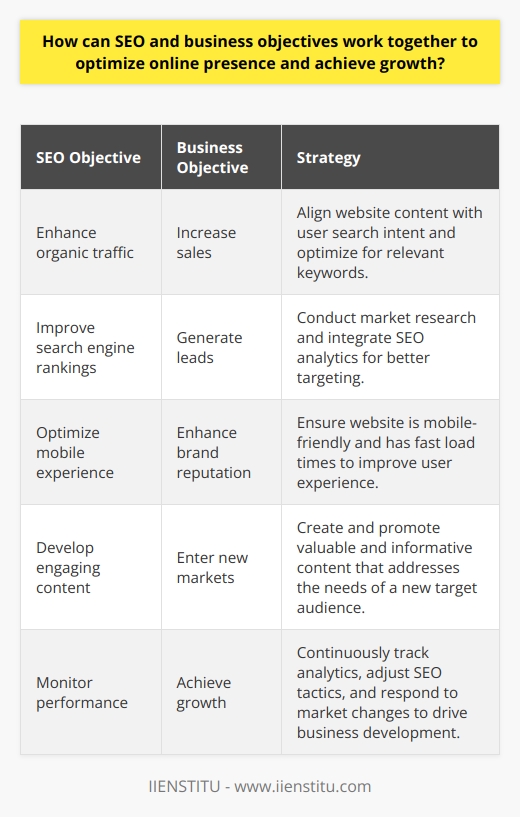
In what ways does SEO priority play a crucial role in strengthening competitive advantage for a business in the digital landscape?
Enhanced Online Visibility
SEO (Search Engine Optimization) priority substantively amplifies a business's competitive advantage in the digital landscape. It principally does so via enhanced online visibility.
Improved Search Engine Rankings
Primarily, SEO improves a business's search engine rankings. A business with a high SEO priority invariably appears at the top of search engine results. This high visibility increases the likelihood of obtaining more clicks and potential customers.
Credibility and Trust
Furthermore, a good SEO strategy fosters credibility and trust among internet users. Businesses with high search engine rankings enjoy a perception of being reputable and trustworthy due to their online presence. Such positive perceptions encourage click-throughs and conversions.
Increased Traffic and Conversions
Powerful SEO strategies also lead to increased traffic and conversions. SEO techniques ensure that a website is easily navigable, user-friendly, and contains relevant content. This not only attracts a higher number of visitors but also enhances user engagement leading to higher conversion rates.
Competitive Edge
Finally, SEO priority gives businesses a competitive edge in the digital landscape. High search engine rankings make businesses more visible than their competitors, allowing them to dominantly communicate their value propositions to potential customers.
Overall, by enhancing online visibility, fostering trust and credibility, increasing traffic and conversion-rates, and offering a competitive edge, SEO priority significantly strengthens a business's competitive advantage in the digital landscape. Consequently, businesses must understand and effectively employ SEO strategies for optimum benefits.
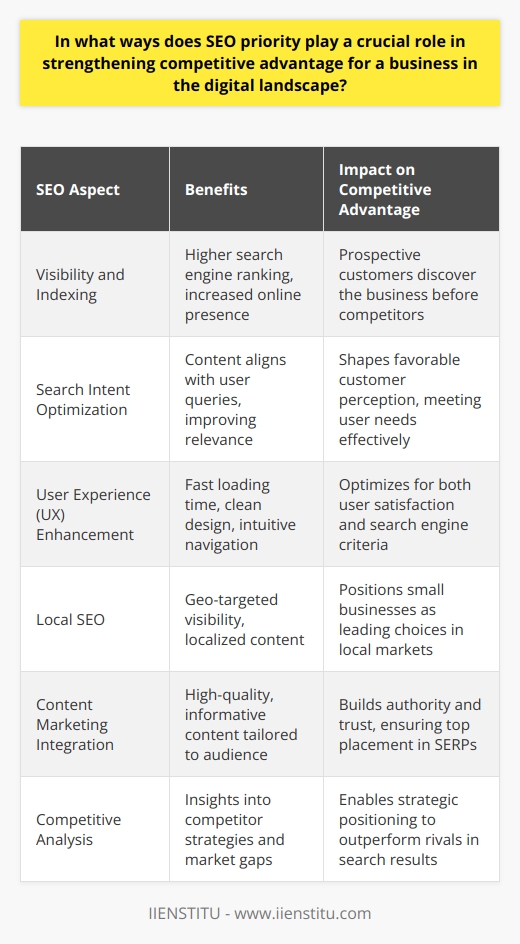
What are the three main objectives of SEO and how do they enhance a business's online visibility and overall marketing performance?
Observe Search Engine Objectives
The primary objectives of Search Engine Optimization (SEO) involve increasing website visibility, enhancing user experience, and improving site credibility. These objectives are instrumental in bolstering a business's online performance and marketing efficiency.
Strengthen Online Presence
The first goal lies in amplifying website visibility. Through meticulous keyword research and website optimization, SEO helps a domain maintain a high ranking on search engine results pages (SERPs). A better ranking means greater visibility, increasing the chance for potential customers to visit your website, thus driving more organic traffic.
Boost User Experience
Secondly, SEO aims to improve the user experience. By ensuring swift website loading times, clear navigation paths, and relevant content for readers, SEO reduces bounce rates and encourages prolonged site interaction. A positive website user experience often translates into higher conversion rates, fostering better customer relationships and strengthening brand loyalty.
Establish Credibility
Lastly, SEO strives to enhance a website’s credibility. Quality backlinks, positive user reviews, and consistent online listing information help establish domain authority, subsequently impacting the website's reputation and reliability. A credible website invariably attracts more traffic, stimulates consumer trust, and augments overall marketing performance.
In essence, SEO, through its primary objectives of increasing visibility, enhancing user experience, and improving site credibility, significantly contributes to a business's online visibility and overall marketing efficacy. Hence, adopting effective SEO strategies becomes indispensable in the digital era for any business aiming for robust growth and sustainability.
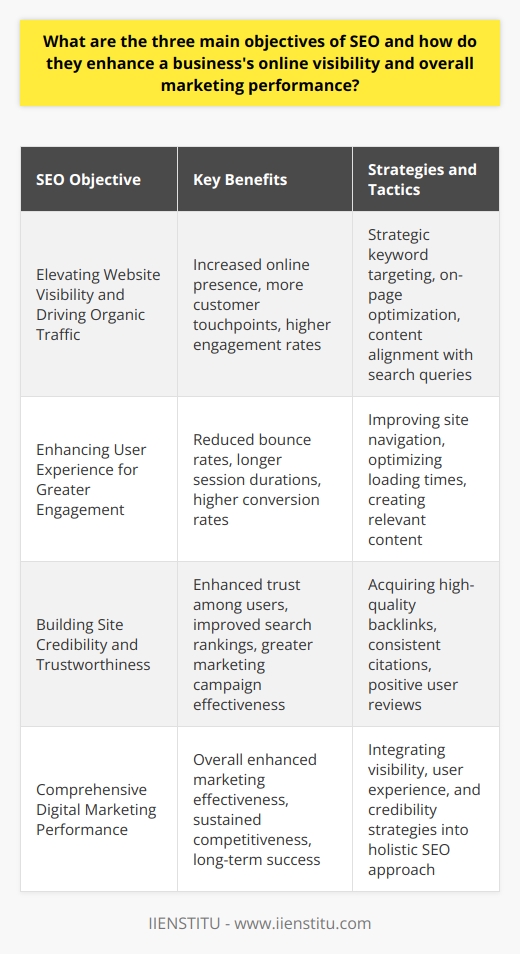
What factors should be considered when determining SEO priority for various website elements and content?
Relevance of Content
When determining SEO priority, first consider the relevance of the content. The information provided should align with the search intent of the user. It must reply to queries effectively while retaining a natural and engaging tone of voice.
Keyword Optimization
Secondly, keyword optimization is vital. The usage of correct and appropriate keywords may increase the visibility of the content in search engine results. However, avoid keyword stuffing, as it could discourage your audience and harm the readability of the content.
Backlink Quality
The third factor is the quality of backlinks. These connections offer a digital recommendation, showcasing the trust and credibility of your website. High-quality backlinks from reputable sources can significantly improve your SEO ranking.
Page Load Speed
The fourth consideration is page load speed. Slow loading pages can increase bounce rates, which negatively affects your site’s SEO. Always look for ways to optimize your site's speed, from compressing images to leveraging browser caching.
Mobile Compatibility
Next, consider the mobile compatibility of your website. As mobile internet usage increases, search engines like Google place a higher importance on mobile-friendly websites. If your site does not adapt to mobile screens, your SEO ranking might suffer.
User Experience
Finally, pay attention to user experience. User-friendly navigation, clear calls-to-action, and intuitive design are significant elements that can influence the user's time spent on site, thereby affecting the site's SEO standing.
In conclusion, several elements need to be considered when determining SEO priority for various website components and content. Balancing these elements effectively can enhance your site's visibility and improve user engagement.
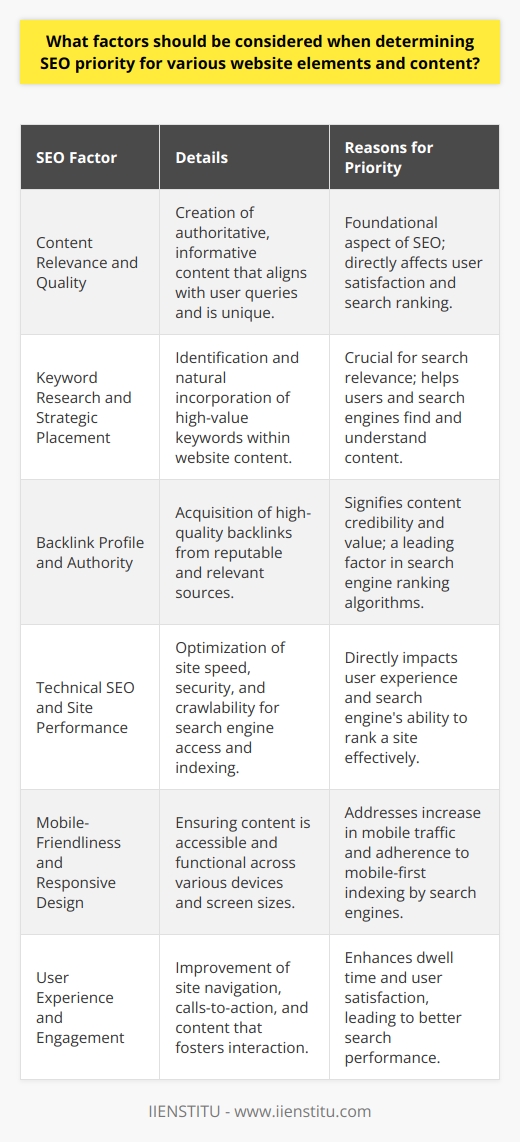
How does understanding user intent and search behavior contribute to establishing SEO priority?
Understanding User Intent
Understanding user intent and search behavior is a key element in establishing SEO priority. User intent embodies the purpose behind a user's search query. When SEO strategists understand user intent, they can optimize their website's content to align with these search queries.
Search Behavior and SEO
Analyzing search behavior comprises the study of the search terms, patterns, and trends used by internet users. This offers invaluable insights into what information users seek, allowing marketers to tailor their content to match these needs. Incorporating these practices makes a site more relevant, improving its search rankings.
Establishing SEO Priority
SEO priority stems from a website's relevancy and the extent to which it meets user demands. By understanding user intent and search behavior, marketers can more accurately assign SEO priority. This enables them to focus on optimizing the most relevant aspects of a website, effectively increasing its visibility.
Improved Web Traffic
When websites have a high SEO priority, they rank higher on search engine results pages. This increases their visibility and the likelihood users will visit them. Therefore, understanding user intent and search behavior is crucial in driving organic web traffic.
Improved User Engagement and Conversion
By tailoring content to user intent, websites can also boost user engagement. This can lead to a higher conversion rate as users find exactly what they're looking for. As a result of effective SEO prioritization, businesses can ultimately see an increase in their conversion rate and ROI.
In conclusion, an understanding of user intent and search behavior is fundamental in establishing SEO priority. By tailoring a website's content to match these, it can increase visibility, drive organic traffic, boost user engagement, and enhance conversion rates.

Can you explain the relationship between SEO priority and a website's overall architecture and organization in enhancing its search performance?
SEO Priority & Website Architecture's Influence on Search Performance
SEO priority plays an integral role in enhancing a website's search performance. The manner in which a website organizes its content and structure directly impacts its SEO efficiency.
Relationship Between SEO and Website Architecture
SEO refers to the process of optimizing web content in order to rank higher in search engine results. Essentially, a website's architecture refers to how its pages interconnect. Good website architecture can make a website more accessible to search engines. Clarity and simplicity of a site's structure are extremely valuable for enhancing SEO effectiveness.
Enhanced Search Performance through SEO
High SEO priority ensures that a website appears more prominently in search engine results. It focuses on strategic keyword usage, meta descriptions, and link-building, among others. A well-organized website helps search engines understand and index its content in a better way, thus improving its search performance.
Role of Website Architecture in SEO
A properly designed website architecture promotes better user experience. It provides straightforward navigation, making it easier for users to find what they need. Additionally, it also helps search engine's bots to crawl and index the website more efficiently. This ease of access and navigability serves as a positive signal to search algorithms, who then award higher rankings to the website.
Website Organization and SEO Priority
Website organization plays a crucial role too. A logically arranged website with well-categorized content tends to attract more traffic. Effective categorization aids users in their search, which in turn sends a positive signal to search engines that the website is reliable. Thus, thoughtful organization enhances a website's SEO priority.
In conclusion, the relationship between SEO priority, website architecture, and organization stands crucial for a website's search performance. A balance of these elements results in improved search visibility, increased web traffic, and ultimately, enhanced website performance.
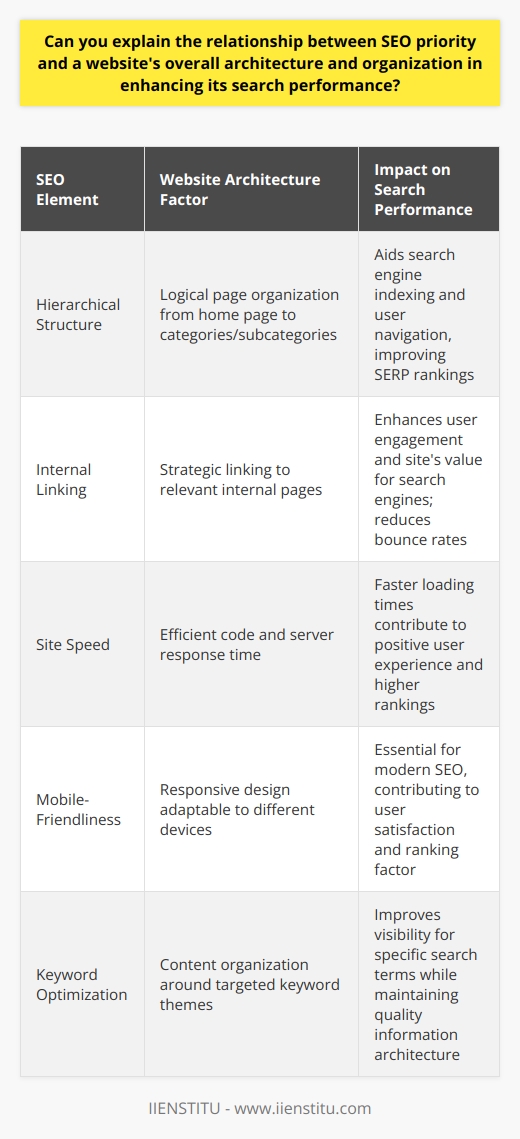
How can SEO boost your business by improving online visibility and attracting potential customers?
Enhanced Online Visibility
SEO, or Search Engine Optimization, amplifies your business's online presence. By leveraging SEO strategies, businesses rank higher in search engine results. When your website appears on the first page, it increases the chances of customers finding your offerings amidst scores of online competition. This elevated visibility can lead to a potential boost in traffic.
Attracting Potential Customers
SEO is not just about attracting any visitor but drawing in the right ones. By analyzing keywords and studying market trends, businesses can refine their SEO strategy to target specific demographics. These actions can attract potential customers who are actively seeking your goods or services. Thus, SEO aids in driving more qualified leads to your website.
Quality of Website Traffic
An effective SEO strategy aims not only to increase the quantity of website traffic but also its quality. SEO enables businesses to draw in visitors most likely to convert into customers. By understanding what these visitors are searching for, businesses can tailor their content, products, and services to meet those needs.
Boosting Sales and Profits
The end goal of any business strategy is profitability. SEO, through enhanced visibility and targeted marketing, can drive more potential customers to the site. An increase in site traffic coupled with a high conversion rate results in boosted sales and profits. Thus, SEO plays a crucial role in enhancing your business's bottom line while achieving sustainable growth.
To conclude, SEO provides businesses the opportunity to boost their online visibility, attract potential customers, improve the quality of website traffic, and ultimately increase sales and profits. It is an indispensable tool in the digital landscape and a potent pathway for businesses looking to scale and succeed in the online marketplace.

What are the three main objectives of SEO that contribute to a business's growth and success in the digital marketplace?
Increasing Website Traffic
The first main objective of Search Engine Optimization (SEO) is to increase website traffic. Whenever individuals search for certain keywords, SEO makes sure a business's website sits on top of the search results page. This high visibility leads to an increase in the number of clicks and website visits.
Enhancing Brand Credibility
The second objective of SEO is to enhance brand credibility. SEO is not just about driving traffic; it's also about establishing trust and credibility to its target audience. Optimal user experience, professional website design, and informative content are factors that convince users of a brand's credibility. When users perceive a brand as trustworthy and credible, the likelihood of them becoming long-term customers increases.
Improving Conversion Rates
Finally, SEO aims to improve conversion rates. SEO achieves this by providing relevant content, a user-friendly web interface, and a smooth browsing experience. When users find pertinent information with ease on a website, they are more likely to make a purchase, increasing sales revenue for the business.
In conclusion, the three main objectives of SEO - increasing website traffic, enhancing brand credibility, and improving conversion rates - collectively contribute to a business's growth and success in the digital marketplace.
Notably, SEO is not a one-time activity but a continuing effort to maintain a business's presence in the fierce digital market competition. It’s essential for businesses to stay up to-date with changing algorithms to sustain and maximize the benefits of their SEO efforts.
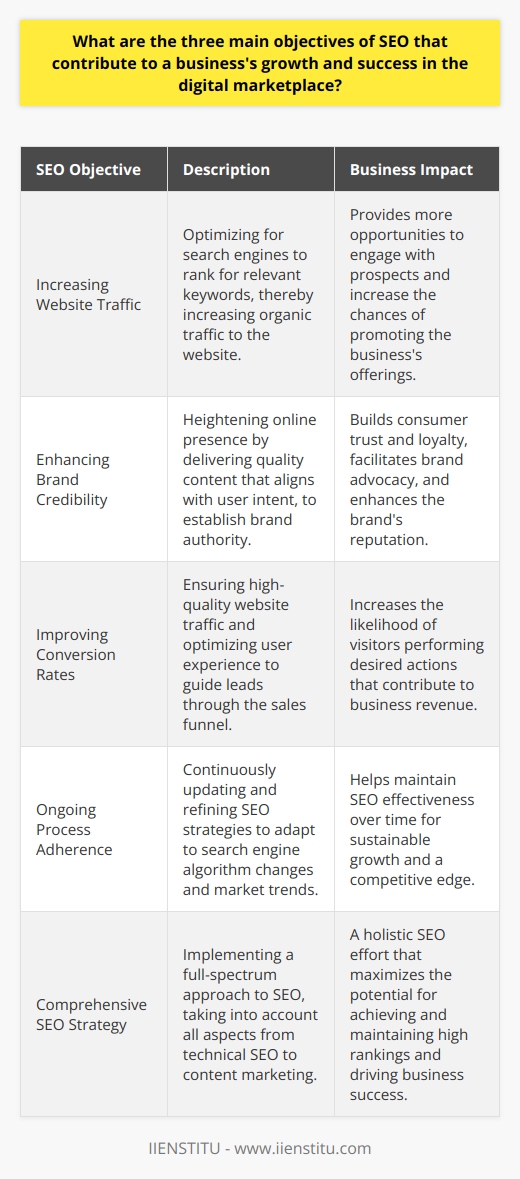
Why is establishing SEO priorities essential for optimizing a website's architecture and organization, and how does this ultimately impact overall business growth?
Key Importance of SEO Priorities
Establishing Search Engine Optimization (SEO) priorities is crucial in optimizing a website's architecture and organization. It guides the design and structuring of a website to ensure that it is user-friendly and search engine-friendly. SEO prioritization involves strategically identifying and focusing on the most impactful SEO tasks.
Influence on Website Organization
Implementing SEO priorities on website content significantly improves its structure. An effective SEO strategy ensures clarity and flow, thus making the website easy to navigate. This enhances user's engagement and contributes to an improved website ranking.
Impact on User Experience
A well-organized website, optimized through SEO, enhances user experience. Superior user experience increases the chance of converting website visitors into potential customers. It also encourages returning visits, which impacts website traffic positively.
Relevance to Business Growth
Ultimately, establishing SEO priorities contributes significantly to overall business growth. It increases website visibility on search engine result pages, resulting in higher traffic. An increased website traffic translates to more customer conversions, thereby positively impacting business profitability.
In Closing
Therefore, the relevance of establishing SEO priorities for optimizing a website's structure and organization cannot be overstated. It not only promotes superior user experience and website engagement, but it also contributes substantially to business growth.
